Translation and voice of the movie house — Indie Game: The Movie Special Edition
In August 2014, my friend and I decided that it would be cool to try to play a movie that is not yet on Russian. The choice fell on the continuation of the documentary about the developers very popular at the time, indie games (Super Meat Boy, FEZ, Braid) — "Indie Game: The Movie Special Edition". 19 clips total length 01:46:55. There was only English subtitles.
Inspired by the existing articles on habré (time, two, three), we set to work. The only thing I was not satisfied with the result in any of the articles, so I decided to go your way in creating the offscreen voice. Below I have tried to discuss in detail, how was the whole process, so my experience might have been of use to someone else. The text will be many, so get ready.

If you are curious just to see what came of it – scroll to the very end.
Used software:
— Cubase LE AI Elements 7 64bit
Adobe Audition CC 2017 ( + vst plugins from Waves)
Adobe Premiere Pro CC 2017
Used iron:
— Usb condenser microphone Behringer C-1U with pop filter
— External sound card Steinberg UR22
— Monitor headphones Fischer Audio FA-003 Ti
— Computer and laptop (I don't think it makes sense to paint the features)
<, h2>0. Preparation
Before to begin work, we decided to figure out what steps will be the process of voice. For this purpose was created a table in google documents.
With it we were able to estimate the amount of work to divide the people we had to name and outline the next steps.
the
On the one hand, we're lucky to have videos already had the subtitles in English. But on the other hand, they were sewn into some kind of player and only appeared when playing back clips through it. While browsing through third-party players (e.g. Media Player Classic) stream with subtitles not just observed. So after a couple hours of agony in an attempt to get a subtitle at least in some form — we gave up and began to kill them manually.
Once I was ready 19 files with English text – can be accepted for transfer. The videos were divided between us to speed up the process. After each of us finished his part – we switched and checked each other, making minor adjustments. This allowed us to achieve the highest quality of translation, which was possible with our levels of knowledge of the English language :D
the
After reading many different articles on the subject, I realized that the biggest problem when writing is to "catch" the effects of the room and extraneous noise, which will be then almost impossible to get rid of. So for voice recording, it was decided to equip the balcony.
The walls were hung with maximum of fleecy blankets to absorb as much sound waves. Part of the balcony depicted in the picture with Irina, who voiced women's and children's roles in the film.
The microphone was connected to the most silent laptop long cable, to the computer was away (just in case).
Actually, on that balcony, we practically lived for a couple of days. Every clip was recorded on five attempts, so I could choose the best parts and reassemble it.
Recommendations:
the
the
Before all this undertaking I was already familiar with the audio editor of Cubase, so it was decided to use it.
So, we have 5 recorded audio tracks with Russian voice for each character of each roller. What's next?
3.1. "Tackling attempts" and "Placement of sentences under the original track"
For each video in the Cubase project was created, consisting of:
— The original English audio track roller
— All other tracks related to this movie and broken the heroes
All audio tracks of each character alternately auditioned, split into phrases and placed in its place under the original English track. After that I listened to all the tracks, determining which of attempts or that phrase sounded better.
In the end, it turned out one solid attempt, collected from several. Perhaps the final screenshot of Cubase will help you better understand what I was talking about above.
This process of selection attempts and parting phrases under the original track was done for each of the rollers 19.
3.2. Sound processing
Everything seemed to be ready. Adjust the volume level of the original English track, a track with a Russian voice acting and voila! But no. Our sound tracks are not yet processed. They are extraneous noise (although we were trying to create the ideal conditions when recording the voices), but the voice still doesn't sound very expressive, and, most likely, lost in the background of the original track. This means that need to do something.
I am grateful that in my search I stumbled upon a youtube channel of a remarkable man (Yuri girls), which very in detail the process of creating offscreen voice. Now I suddenly discovered that he removed from his channel a video in which talked about the processing of voice, but what to do, apparently this was the cause. So I will try to outline the main points in the article.
After reviewing all the tips, I realized that the voice processing I have Adobe Audition, as all competent how-to on the Internet shows it.
Next, I broke the voice processing into the following stages:
3.2.1 FFT Filter – remove low and high noise,
3.2.2 Noise Reduction – the removal of hard noise,
3.2.3 Waves C1 Gate – remove noise
3.2.4 Graphic Equalizer – equalization voice
3.2.5 PSP VintageWarmer2 — heated voice
3.2.6 Speech Volume Leveler — the leveling of the volume of the voice
3.2.7 Multiband Compressor — remove whistling and other extraneous sounds of voices
3.2.9 Tube-modeled Compressor — compression voice
3.2.10 Hard Limiter — limits the voice
3.2.11 Normalize — normalization
The items Unselected fat, when you work with the voice acting, I was spared, as he felt that in my case they should not be affected (due to irrelevance or my inexperience).
Now I'd like to write each paragraph to make this article a reminder primarily for myself, if I suddenly want to announce something else, and of course for you.
All steps below I did in Adobe Audition with every Russian audio track. Then I went back to Cubase, which pulled in all the changes after the Audition, and it exported the finished track with a Russian voice acting.
3.3. Mixing Russian tracks "dachigam" with the original track (Waves C1 Gate)
Now that we have cleansed our voice from all the unnecessary noise, highlighted his features, and did the other treatments, we only need to reduce obtained the Russian track with English original. I did this in Adobe Audition too.
Here I will advise you to watch video of Yuri Gurov, which I mentioned above. Everything is clear and explained in detail how it could be done better. Here I just give you some settings so you can refer to them.
Inspired by the existing articles on habré (time, two, three), we set to work. The only thing I was not satisfied with the result in any of the articles, so I decided to go your way in creating the offscreen voice. Below I have tried to discuss in detail, how was the whole process, so my experience might have been of use to someone else. The text will be many, so get ready.

If you are curious just to see what came of it – scroll to the very end.
Used software:
— Cubase LE AI Elements 7 64bit
Adobe Audition CC 2017 ( + vst plugins from Waves)
Adobe Premiere Pro CC 2017
Used iron:
— Usb condenser microphone Behringer C-1U with pop filter
— External sound card Steinberg UR22
— Monitor headphones Fischer Audio FA-003 Ti
— Computer and laptop (I don't think it makes sense to paint the features)
<, h2>0. Preparation
Before to begin work, we decided to figure out what steps will be the process of voice. For this purpose was created a table in google documents.
Google chart progress

With it we were able to estimate the amount of work to divide the people we had to name and outline the next steps.
the
1. Translation
On the one hand, we're lucky to have videos already had the subtitles in English. But on the other hand, they were sewn into some kind of player and only appeared when playing back clips through it. While browsing through third-party players (e.g. Media Player Classic) stream with subtitles not just observed. So after a couple hours of agony in an attempt to get a subtitle at least in some form — we gave up and began to kill them manually.
Once I was ready 19 files with English text – can be accepted for transfer. The videos were divided between us to speed up the process. After each of us finished his part – we switched and checked each other, making minor adjustments. This allowed us to achieve the highest quality of translation, which was possible with our levels of knowledge of the English language :D
the
2. Nachitka
After reading many different articles on the subject, I realized that the biggest problem when writing is to "catch" the effects of the room and extraneous noise, which will be then almost impossible to get rid of. So for voice recording, it was decided to equip the balcony.
The walls were hung with maximum of fleecy blankets to absorb as much sound waves. Part of the balcony depicted in the picture with Irina, who voiced women's and children's roles in the film.
balcony

The microphone was connected to the most silent laptop long cable, to the computer was away (just in case).
Actually, on that balcony, we practically lived for a couple of days. Every clip was recorded on five attempts, so I could choose the best parts and reassemble it.
Recommendations:
the
- Try not to clench my teeth and lips, but rather more to move them (you can even gesticulating with his hands, if it will help you speak with greater looseness) that the words sounded clearer and clearer.
!!! Before you start to record the text, hold the microphone about 20 seconds and just shut up. So at this point, the microphone was recording exclusively with extraneous sounds (noise of the cooler of the computer, the wind outside the window, drill the neighbors above, etc.). In the future it will help you to remove all the unnecessary sounds from the record, leaving only your clean voice. the
the
3. Sound
Before all this undertaking I was already familiar with the audio editor of Cubase, so it was decided to use it.
So, we have 5 recorded audio tracks with Russian voice for each character of each roller. What's next?
3.1. "Tackling attempts" and "Placement of sentences under the original track"
For each video in the Cubase project was created, consisting of:
— The original English audio track roller
— All other tracks related to this movie and broken the heroes
All audio tracks of each character alternately auditioned, split into phrases and placed in its place under the original English track. After that I listened to all the tracks, determining which of attempts or that phrase sounded better.
In the end, it turned out one solid attempt, collected from several. Perhaps the final screenshot of Cubase will help you better understand what I was talking about above.
the Project in Cubase

regarding how best to frame the Russian phrase under the English track: simultaneously with the beginning of English, later some time after the beginning of the English or even before English?
I thought about it for quite some time and experimented a lot, and eventually came to the following conclusion:
the
the
-
the
- If, at the time of sounding phrases the person who says it, is not in the frame – it is best to make the end of the English phrase coincided with the end of the Russian.
the - If, at the time of sounding phrases the person who says it, is in the frame – it is better to achieve the effect of maximum contact phrase in the movement of the lips of speaking person. Where it will be almost impossible to do, because during nachitki text you did not consider that the English phrase may sound shorter/longer than the Russian. And here already you will have to experiment, try to get into some kind of harmony or intonation / facial expressions of the hero. The more you zaporojets – the better will the result
This process of selection attempts and parting phrases under the original track was done for each of the rollers 19.
3.2. Sound processing
Everything seemed to be ready. Adjust the volume level of the original English track, a track with a Russian voice acting and voila! But no. Our sound tracks are not yet processed. They are extraneous noise (although we were trying to create the ideal conditions when recording the voices), but the voice still doesn't sound very expressive, and, most likely, lost in the background of the original track. This means that need to do something.
I am grateful that in my search I stumbled upon a youtube channel of a remarkable man (Yuri girls), which very in detail the process of creating offscreen voice. Now I suddenly discovered that he removed from his channel a video in which talked about the processing of voice, but what to do, apparently this was the cause. So I will try to outline the main points in the article.
After reviewing all the tips, I realized that the voice processing I have Adobe Audition, as all competent how-to on the Internet shows it.
Next, I broke the voice processing into the following stages:
3.2.1 FFT Filter – remove low and high noise,
3.2.2 Noise Reduction – the removal of hard noise,
3.2.3 Waves C1 Gate – remove noise
3.2.4 Graphic Equalizer – equalization voice
3.2.5 PSP VintageWarmer2 — heated voice
3.2.6 Speech Volume Leveler — the leveling of the volume of the voice
3.2.7 Multiband Compressor — remove whistling and other extraneous sounds of voices
3.2.9 Tube-modeled Compressor — compression voice
3.2.10 Hard Limiter — limits the voice
3.2.11 Normalize — normalization
The items Unselected fat, when you work with the voice acting, I was spared, as he felt that in my case they should not be affected (due to irrelevance or my inexperience).
Now I'd like to write each paragraph to make this article a reminder primarily for myself, if I suddenly want to announce something else, and of course for you.
All steps below I did in Adobe Audition with every Russian audio track. Then I went back to Cubase, which pulled in all the changes after the Audition, and it exported the finished track with a Russian voice acting.
3.2.1 FFT Filter – remove low and high noise
the Path to effect in Adobe Audition: Effects > Filter &EQ > FFT Filter
1. On the chart we arrange the four points as shown in the first screenshot. So we cut off from the sound area is restricted with the low frequencies (in the screenshot 100 Hertz and below). You should start with 40-50 Hz and gradually increase the border until you start to hear sounds resembling the human voice :D
2. Once You have found that frequency — swap the data points so this time we took on the audio track only "useful" part of the sound is free of noise (second screenshot).
3. It is now possible to apply the effect to the whole track.
note: Also you can try to do this trick in the opposite direction, starting to go from the top frequency to the bottom until you find that you begin to hear the voice. But we have to be careful, because you can crop a very important Sizzling and whistling sounds that accentuate your speech, not spoil it.
FFT Filter (step # 1)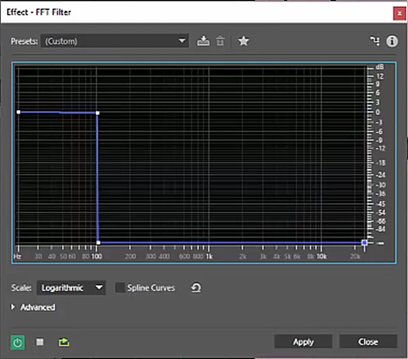

1. On the chart we arrange the four points as shown in the first screenshot. So we cut off from the sound area is restricted with the low frequencies (in the screenshot 100 Hertz and below). You should start with 40-50 Hz and gradually increase the border until you start to hear sounds resembling the human voice :D
2. Once You have found that frequency — swap the data points so this time we took on the audio track only "useful" part of the sound is free of noise (second screenshot).
FFT Filter (step 2)

3. It is now possible to apply the effect to the whole track.
note: Also you can try to do this trick in the opposite direction, starting to go from the top frequency to the bottom until you find that you begin to hear the voice. But we have to be careful, because you can crop a very important Sizzling and whistling sounds that accentuate your speech, not spoil it.
3.2.2 Noise Reduction – the removal of hard noise,
the Path to effect in Adobe Audition: Effects > Noise Reduction
1. Find a segment in the audio track where there is ONLY a uniform noise (for this I recommend you during voice recording, wait 20 seconds and then start talking). Select this section.
2. Add the effect of Noise Reduction.
3. Put FFT Size from 512 to 2048 (by ear, then you need to experiment). After you change this value every time you click Capture Noise Print below the noise zahvatila with the new settings.
4. Noise Reduction is better to put 80%. Reduce by (dB) is chosen for the hearing.
Suggest moving the slider to the bottom-up then top-down to catch the desired value when the noise ceases to be heard, and the voice will not be made practically no impact. Below 90 dB sound for a hearing is not perceived (for myself, I decided that I didn't hear the noise below 83 dB).
Effect Noise Reduction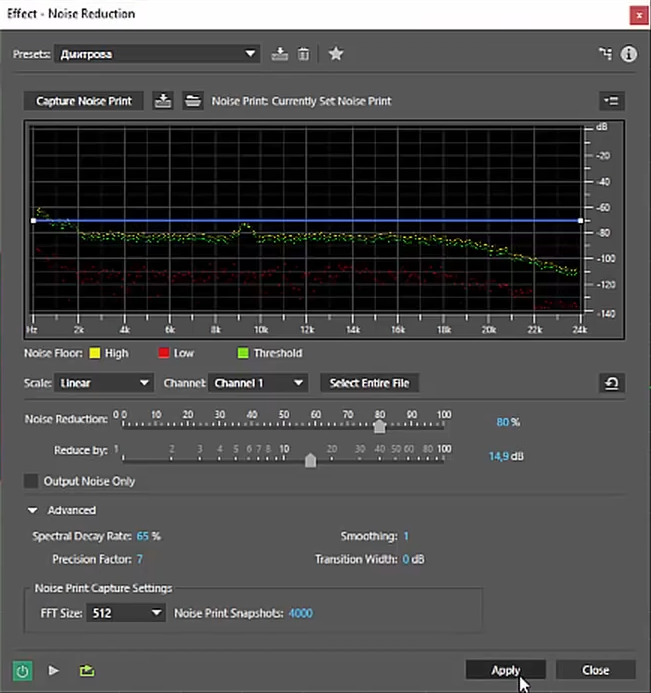

1. Find a segment in the audio track where there is ONLY a uniform noise (for this I recommend you during voice recording, wait 20 seconds and then start talking). Select this section.
2. Add the effect of Noise Reduction.
3. Put FFT Size from 512 to 2048 (by ear, then you need to experiment). After you change this value every time you click Capture Noise Print below the noise zahvatila with the new settings.
4. Noise Reduction is better to put 80%. Reduce by (dB) is chosen for the hearing.
Suggest moving the slider to the bottom-up then top-down to catch the desired value when the noise ceases to be heard, and the voice will not be made practically no impact. Below 90 dB sound for a hearing is not perceived (for myself, I decided that I didn't hear the noise below 83 dB).
3.2.3 Waves C1 Gate – remove noise
the Path to effect in Adobe Audition: (this plugin you need to download on the Internet and installed separately)
1. Allocated to the quiet phrase and it is rebuilding the opening and closing of the gate (Gate Open and Gate Close).
2. For the following parameters can be directly set certain values: Attack – 1.51, Release 30.
3. Reduce the threshold of discovery until, while she quiet the phrase "will not sagatavots" plugin. That means it's time to stop and pry the threshold open, that the phrase clearly.
note: the Difference between Open and Closed should be approximately 10 dB (Open must be greater than).
Waves C1 Gate Effect

1. Allocated to the quiet phrase and it is rebuilding the opening and closing of the gate (Gate Open and Gate Close).
2. For the following parameters can be directly set certain values: Attack – 1.51, Release 30.
3. Reduce the threshold of discovery until, while she quiet the phrase "will not sagatavots" plugin. That means it's time to stop and pry the threshold open, that the phrase clearly.
note: the Difference between Open and Closed should be approximately 10 dB (Open must be greater than).
3.2.4 Graphic Equalizer – equalization voice
the Path to effect in Adobe Audition: Effects > Filter &EQ > Graphic Equalizer (30 Bands)...
Here, alas, there are no secrets.
For female voice you can "cut" (as srinshote) all to 80 Hz. For men to 63 Hz. Other frequencies – raise and lower at your discretion.
Personally, I was afraid to go into the equalization, not knowing all the details of this procedure, so this point I am spared, in the hope that the microphone for 4 thousand rubles more or less coped with the task of recording voices :D
Effect Graphic Equalizer

Here, alas, there are no secrets.
For female voice you can "cut" (as srinshote) all to 80 Hz. For men to 63 Hz. Other frequencies – raise and lower at your discretion.
Personally, I was afraid to go into the equalization, not knowing all the details of this procedure, so this point I am spared, in the hope that the microphone for 4 thousand rubles more or less coped with the task of recording voices :D
3.2.5 PSP VintageWarmer2 - heated voice
the Path to effect in Adobe Audition: (this plugin you need to download on the Internet and installed separately)
If you feel that your voice lacks some colors, you can try to warm up the voice plugin from VintageWarmer.
Option Release suggest to set to the Auto position. In the High parameters and Freq to select the desired preheating frequency and level how you want it to "warm up".
Here, too, everything is quite individual, so I did not use this plugin when working with his voice. However, I've seen what it can really do wonders with voices. If there is a desire – you can try to experiment with it.
Effect PSP VintageWarmer2

If you feel that your voice lacks some colors, you can try to warm up the voice plugin from VintageWarmer.
Option Release suggest to set to the Auto position. In the High parameters and Freq to select the desired preheating frequency and level how you want it to "warm up".
Here, too, everything is quite individual, so I did not use this plugin when working with his voice. However, I've seen what it can really do wonders with voices. If there is a desire – you can try to experiment with it.
3.2.6 Speech Volume Leveler - levelling the volume
the Path to effect in Adobe Audition: Effects > Amplitude &Compression > Speech Volume Leveler
After voice recording, it may happen that you have some places will have very different volume levels of your voice (somewhere you cried, and then spoke in a whisper).
This effect will help to bring the volume of phrases to the same level.
1. Allocated in the track the loud phrase, and move the Target Volume Level down until you notice that the effect has virtually no effect on her. This means that it is possible to stop.
2. Once such a value was found, we begin to pick up a Leveling Amount (zero or above) and see that quiet phrase started becoming the same level as the loud phrase.
3. Now apply the effect to the whole track.
After voice recording, it may happen that you have some places will have very different volume levels of your voice (somewhere you cried, and then spoke in a whisper).
This effect will help to bring the volume of phrases to the same level.
Effect Speech Volume Leveler (step # 1)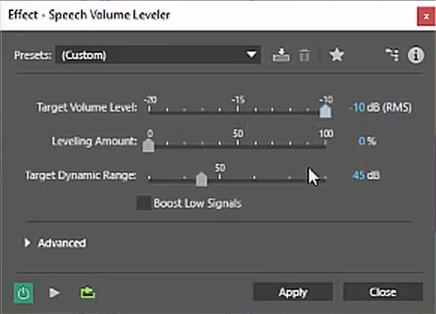

1. Allocated in the track the loud phrase, and move the Target Volume Level down until you notice that the effect has virtually no effect on her. This means that it is possible to stop.
2. Once such a value was found, we begin to pick up a Leveling Amount (zero or above) and see that quiet phrase started becoming the same level as the loud phrase.
Effect Speech Volume Leveler (step # 2)

3. Now apply the effect to the whole track.
3.2.7 Multiband Compressor - remove whistling and other ambient sounds
the Path to effect in Adobe Audition: Effects > Amplitude &Compression > Multiband Compressor
The effect I used in order to suppress the hissing/whistling sounds and low sounds boomy.
1. The crossover settings I set as follows: low – 350, mid – 4000, high – 9122.7 (with high possible to play silent left/right).
2. The values for Gain, Ratio, Attack and Release should be set to each area as follows: Gain — 0, Ratio 3, Attack — 0, Release 100.
3. Then you start to listen to the audio track, click the solo is only one of the areas, trying to pick for each such parameter threshold'and that you want (here, too, no secrets, just listen and move the slider threshold'and to have enjoyed yourself).
The effect I used in order to suppress the hissing/whistling sounds and low sounds boomy.
Effect Multiband Compressor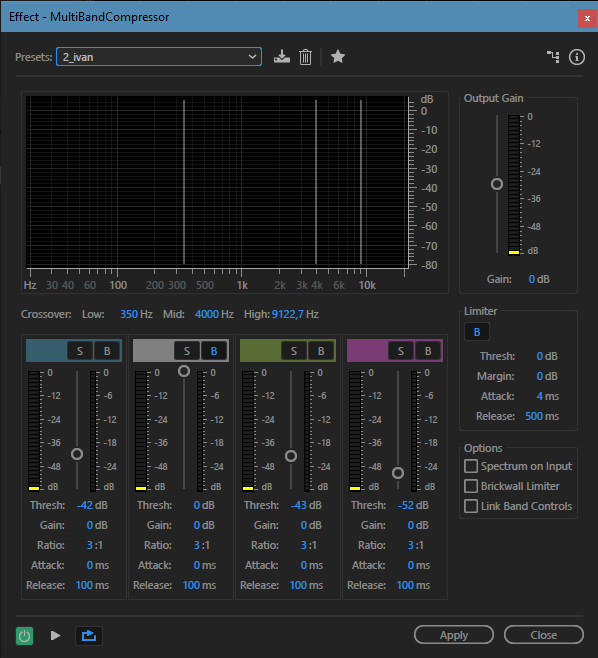

1. The crossover settings I set as follows: low – 350, mid – 4000, high – 9122.7 (with high possible to play silent left/right).
2. The values for Gain, Ratio, Attack and Release should be set to each area as follows: Gain — 0, Ratio 3, Attack — 0, Release 100.
3. Then you start to listen to the audio track, click the solo is only one of the areas, trying to pick for each such parameter threshold'and that you want (here, too, no secrets, just listen and move the slider threshold'and to have enjoyed yourself).
3.2.8 SPL De-Verb - remove room
the Path to effect in Adobe Audition: (this plugin you need to download on the Internet and installed separately)
This plugin will help you to remove from your record "room effect", when it does get through.
Turn left switch to select the value at which your phrase will not be "zazhevyvaya" plugin. Once you have selected the desired value – apply the effect to the whole track.
This plugin will help you to remove from your record "room effect", when it does get through.
Effect SPL De-Verb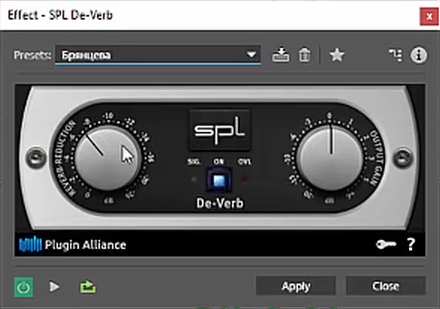

Turn left switch to select the value at which your phrase will not be "zazhevyvaya" plugin. Once you have selected the desired value – apply the effect to the whole track.
3.2.9 Tube-modeled Compressor - compression voice
the Path to effect in Adobe Audition: Effects > Amplitude &Compression > Tube-modeled Compressor
This effect will help your voice "stand out" when applying with an English track.
Select option thresh, in a voice naturally, but stressed (probably said not very clear, but when you start moving this slider you will see what I mean :D).
Other settings:
Gain — 0
Ratio – 3 (for voice 3 (get a more powerful compression; threshold exhibit lower) to 5 (receive only crush the volume of the peaks; threshold exhibited exactly in the middle of the volume))
Attack — 0
Release – 100 (from 100 to 300 at your discretion)
This effect will help your voice "stand out" when applying with an English track.
Effect Tube-modeled Compressor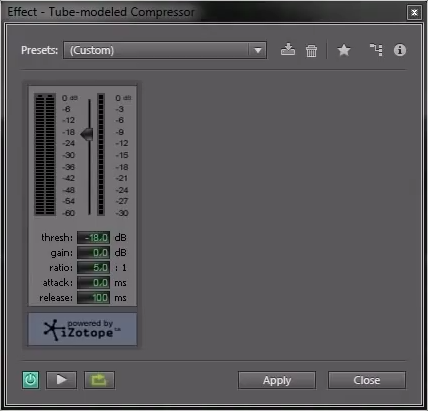

Select option thresh, in a voice naturally, but stressed (probably said not very clear, but when you start moving this slider you will see what I mean :D).
Other settings:
Gain — 0
Ratio – 3 (for voice 3 (get a more powerful compression; threshold exhibit lower) to 5 (receive only crush the volume of the peaks; threshold exhibited exactly in the middle of the volume))
Attack — 0
Release – 100 (from 100 to 300 at your discretion)
3.2.10 Hard Limiter - limits the voices
the Path to effect in Adobe Audition: Effects > Amplitude & Compression > Hard Limitter
If after all above actions are done, we want to get rid of any peaks in the volume of the voice – it can be done roughly by the limiter.
Set the maximum amplitude to cut off the unwanted.
Expose the parameters "Input Boost", "Look-Ahead Time" and "Release Time" values are 0, 5 and 40.
If after all above actions are done, we want to get rid of any peaks in the volume of the voice – it can be done roughly by the limiter.
Effect Hard Limiter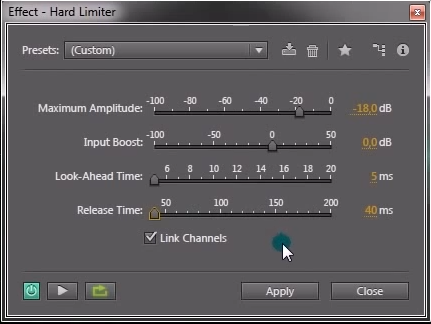

Set the maximum amplitude to cut off the unwanted.
Expose the parameters "Input Boost", "Look-Ahead Time" and "Release Time" values are 0, 5 and 40.
3.2.11 Normalize - normalization voices
the Path to effect in Adobe Audition: Effects > Amplitude &Compression > Normalize
This effect allows you to normalize the track (to raise the volume level) to a certain value (for example, I was raised to -3 dB).
Effect Normalize

This effect allows you to normalize the track (to raise the volume level) to a certain value (for example, I was raised to -3 dB).
3.3. Mixing Russian tracks "dachigam" with the original track (Waves C1 Gate)
Now that we have cleansed our voice from all the unnecessary noise, highlighted his features, and did the other treatments, we only need to reduce obtained the Russian track with English original. I did this in Adobe Audition too.
Here I will advise you to watch video of Yuri Gurov, which I mentioned above. Everything is clear and explained in detail how it could be done better. Here I just give you some settings so you can refer to them.
description of the process, "dachigam"
Create a new project in Adobe Audition. It throws the original track and exported from Cubase track with the Russian.
To prepare the English track for the record, I decided to cut from them the voice effect Center Channel Extractor (preset Vocal Remove). You can play around with the settings for each clip, I managed to cut the volume of voices without affecting the background music.
Next, the principle is the following: You create three audio tracks in the project. On two you will have to lie on the original English audio track, and the third your Russian voice. Adjust the volume level of the three tracks to become the same everywhere. One of the English tracks an expandable phase (Polarity Reverse). Now, with an equal volume of these two tracks, they will be subtracted from each other. And if you turn up at a time they do not hear anything, only silence.
Deployed phase track is made quieter by 6 db. She hung the C1 Gate plug-in Stereo with the following settings: Attack – 5.5, Release 209, Type – Gate.
the
And now, when I had a complete audio track, I could just add them to the video, but we decided to bother even more and translate some names in the video.
To translate the inscriptions can be in two ways:
In the first case everything is simple: in the editor you create a rectangle of black color in a certain area to close them an English inscription, and over the desired font, write Russian. But to do so everywhere was not very nice, because it spoils the picture or is closed need the details. Therefore, where possible, I tried to use the second method. (By the way, the fonts have been specially selected are the same as in the original English captions. The Internet was many sites are able to recognize the font on the screenshot, so that this problem does not arise. Who cares – this film uses the fonts century gothic bold, you can download it from the site ufonts.com).
To do this, I duplicated the sequence to the desired seconds. In the track, which goes on top of the other, cut crop'Ohm rectangular area to which to apply the fast blur effect. Then, on top of all this is written Russian text.
The result is pretty pleasing to the eye.
the
That's all!)
So it became clear that we have left, give an example of two videos:
Other videos you may want to see here.
I have tried to describe all the stages of the creation of our other voice. Perhaps, somewhere, was nevertheless omitted the description of some routine. If any of this is not sufficiently detailed – please write in the comments and I will try to add to it.
From myself I can add that the result I'm rather pleased with it.
Believe me, after you spent hours listening to and looking at something, eyes and ears begin to zamylivaetsya to horror. So I, alas, be objective about your own work.
What advice I can give to myself for the future?
Probably, the first is to switch completely to products from Adobe, refusing to Cubase. Because it was not very convenient: cut and glue the pieces in Cubase is treated in the Audition, then I go back into Cubase, etc...
Second – stop repeating the text from the worksheet. It was a very big mistake, because lost a tone. Also some phrases was longer or shorter than required, which has led to problems in fitting phrases beneath the original track.
Third – to unsubscribe from the system when you first write down a bunch of attempts, and then sit and choose from them the best pieces. It was very dreary and uncomfortable. It is much better to write a pair of sentences and see how they suits you. And not to go to the next, until I finish with these. On the one hand, this will stretch the recording process, but will save a lot of time on, because then it will be necessary just to process the voice.
I bid you adieu.
Looking forward to your feedback!
Article based on information from habrahabr.ru
To prepare the English track for the record, I decided to cut from them the voice effect Center Channel Extractor (preset Vocal Remove). You can play around with the settings for each clip, I managed to cut the volume of voices without affecting the background music.
Next, the principle is the following: You create three audio tracks in the project. On two you will have to lie on the original English audio track, and the third your Russian voice. Adjust the volume level of the three tracks to become the same everywhere. One of the English tracks an expandable phase (Polarity Reverse). Now, with an equal volume of these two tracks, they will be subtracted from each other. And if you turn up at a time they do not hear anything, only silence.
Deployed phase track is made quieter by 6 db. She hung the C1 Gate plug-in Stereo with the following settings: Attack – 5.5, Release 209, Type – Gate.
Effect C1 Stereo Gate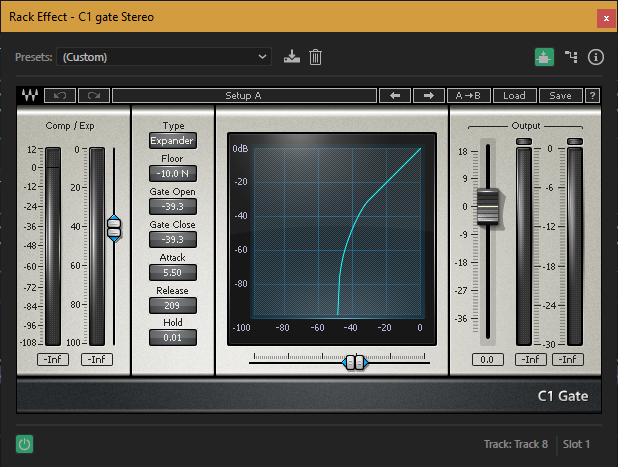
Top plugin, you choose "Set Side-Chain Input". Then you send a message to the Russian audio track in this plugin, and the fun begins. At the same time you include all of the tracks. On the chart you will see how to run a strip in the plug-in on Russian fragments of voices. You have to remember approximately what volume level is your speech, and for that value to set the Gate Open and Gate Close (their values must be identical) and then change the Type parameter on the "Expander", and set the Floor in "-10.0 N" (from Floor can be a little play by ear). Thus, the Russian phrase to English original audio track will podkashivatsya its expanded phase, the copy, making the total English audio quieter. It's like if you put someone who'd twisted the knob volume English tracks up and down, gradually subtracting the English language, so it does not interfere Russian, then adding it when it will not interfere. That's the whole secret.
After that, feel free to make a mix of all audio tracks function, the mixdown and the track, which can substitute for your video.

Top plugin, you choose "Set Side-Chain Input". Then you send a message to the Russian audio track in this plugin, and the fun begins. At the same time you include all of the tracks. On the chart you will see how to run a strip in the plug-in on Russian fragments of voices. You have to remember approximately what volume level is your speech, and for that value to set the Gate Open and Gate Close (their values must be identical) and then change the Type parameter on the "Expander", and set the Floor in "-10.0 N" (from Floor can be a little play by ear). Thus, the Russian phrase to English original audio track will podkashivatsya its expanded phase, the copy, making the total English audio quieter. It's like if you put someone who'd twisted the knob volume English tracks up and down, gradually subtracting the English language, so it does not interfere Russian, then adding it when it will not interfere. That's the whole secret.
After that, feel free to make a mix of all audio tracks function, the mixdown and the track, which can substitute for your video.
the
4. Video
And now, when I had a complete audio track, I could just add them to the video, but we decided to bother even more and translate some names in the video.
To translate the inscriptions can be in two ways:
Method # 1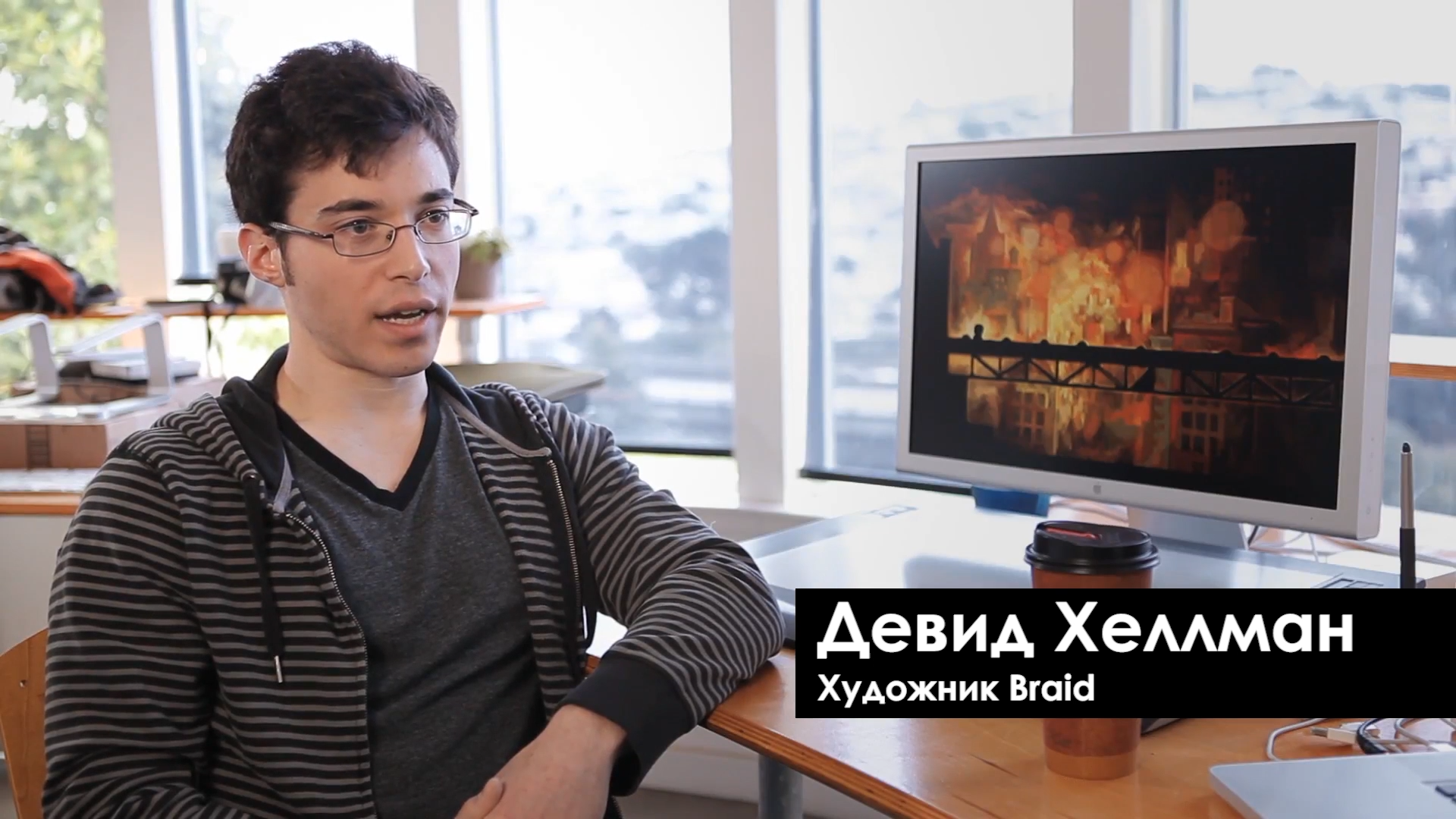

Method # 2

In the first case everything is simple: in the editor you create a rectangle of black color in a certain area to close them an English inscription, and over the desired font, write Russian. But to do so everywhere was not very nice, because it spoils the picture or is closed need the details. Therefore, where possible, I tried to use the second method. (By the way, the fonts have been specially selected are the same as in the original English captions. The Internet was many sites are able to recognize the font on the screenshot, so that this problem does not arise. Who cares – this film uses the fonts century gothic bold, you can download it from the site ufonts.com).
To do this, I duplicated the sequence to the desired seconds. In the track, which goes on top of the other, cut crop'Ohm rectangular area to which to apply the fast blur effect. Then, on top of all this is written Russian text.
a Project in Adobe Premiere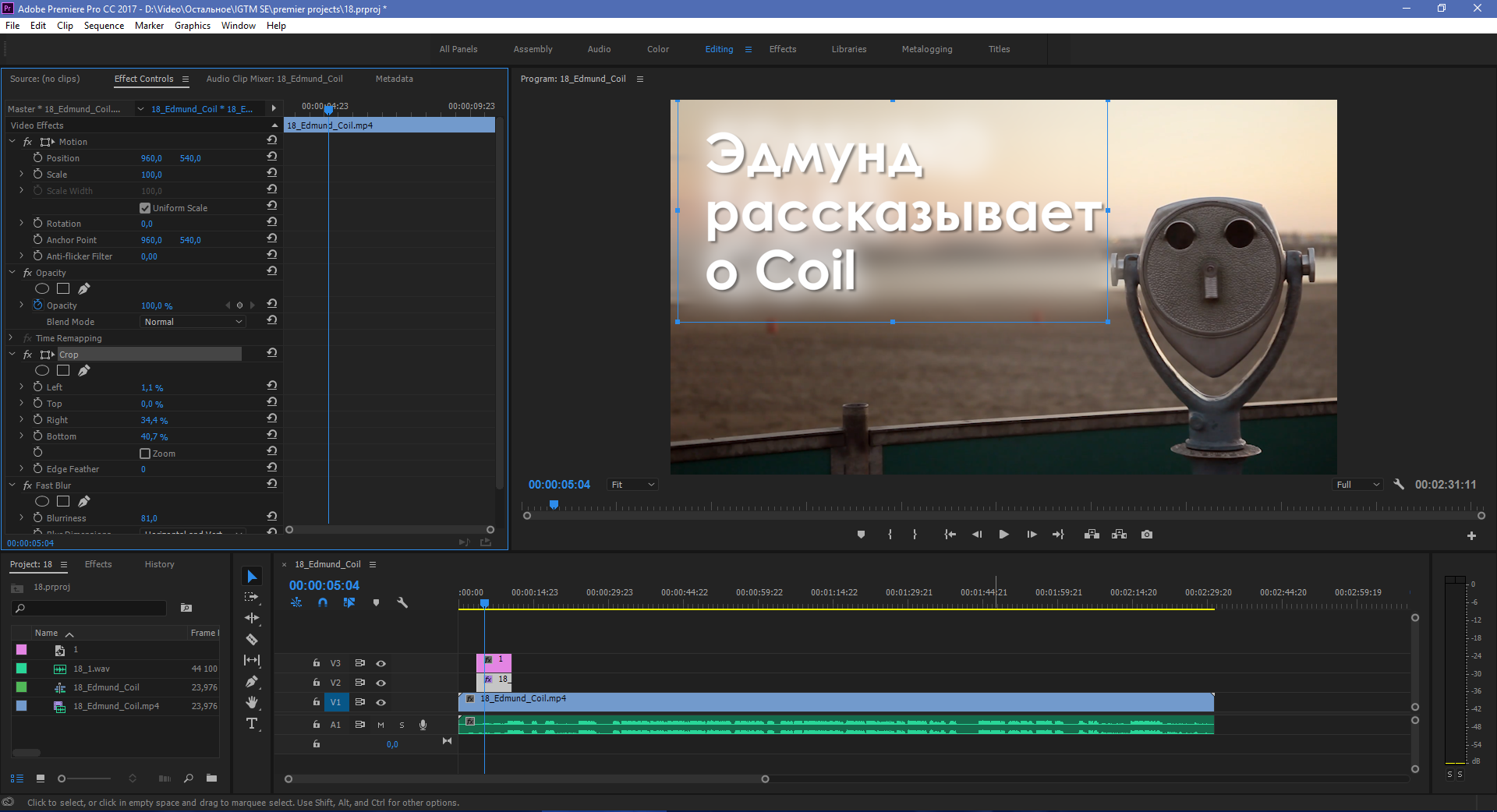

The result is pretty pleasing to the eye.
the
5. Conclusion
That's all!)
So it became clear that we have left, give an example of two videos:
Other videos you may want to see here.
I have tried to describe all the stages of the creation of our other voice. Perhaps, somewhere, was nevertheless omitted the description of some routine. If any of this is not sufficiently detailed – please write in the comments and I will try to add to it.
From myself I can add that the result I'm rather pleased with it.
Believe me, after you spent hours listening to and looking at something, eyes and ears begin to zamylivaetsya to horror. So I, alas, be objective about your own work.
What advice I can give to myself for the future?
Probably, the first is to switch completely to products from Adobe, refusing to Cubase. Because it was not very convenient: cut and glue the pieces in Cubase is treated in the Audition, then I go back into Cubase, etc...
Second – stop repeating the text from the worksheet. It was a very big mistake, because lost a tone. Also some phrases was longer or shorter than required, which has led to problems in fitting phrases beneath the original track.
Third – to unsubscribe from the system when you first write down a bunch of attempts, and then sit and choose from them the best pieces. It was very dreary and uncomfortable. It is much better to write a pair of sentences and see how they suits you. And not to go to the next, until I finish with these. On the one hand, this will stretch the recording process, but will save a lot of time on, because then it will be necessary just to process the voice.
I bid you adieu.
Looking forward to your feedback!
Комментарии
Отправить комментарий